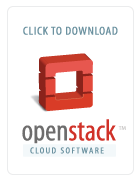What is OpenStack? Who might use it?
OpenStack is an open source cloud operating system written in
Python
to manage pools of compute, storage, and networking resources via
command-line interface (CLI) or a web-based dashboard. It is designed to
run on commodity hardware and is sometimes referred as Infrastructure
as a Service (IaaS). OpenStack runs on common Linux platforms such as
RHEL, SUSE, or Ubuntu.
OpenStack is an infrastructure (or in simpler terms, a cloud). It can
create an environment that provides on-demand increase or decrease of
resource allocation, and the resources are not limited to a single
location. Big data, web services, and Network Function Virtualization
(NFV) for service providers are all good applications for OpenStack.
What are the key services and components of OpenStack? What do they do?
OpenStack follows a bi-annual release cycle, with each release
identified by a name instead of number, so the first release was Austin,
the current release is Mitaka, and the previous releases were Liberty
and Kilo, respectively. Since the Kilo release, OpenStack has started to
shift from the incubation/integrated model to the Big Tent model, where projects are tagged with specific attributes.
The major components of a cloud infrastructure are compute, storage,
and networking. These used to be called the core services of OpenStack,
while all others were called the shared services.
Compute:
- Nova: Provides virtual machines (VMs) on demand.
Storage:
- Swift: Provides a scalable storage system that supports object storage.
- Cinder: Provides persistent block storage to guest VMs.
Networking:
- Neutron: Provides network connectivity as a service between interface devices managed by OpenStack services.
Shared services:
- Keystone: Provides authentication and authorization for all the OpenStack services.
- Glance: Provides a catalog and repository for virtual disk images.
- Horizon: Provides a modular, web-based user interface for OpenStack services.
- Ceilometer: Provides a single point of contact for billing systems.
- Heat: Provides orchestration services for multiple composite cloud applications.
- Trove: Provides database-as-a-service (DBaaS) provisioning for relational and non-relational database engines.
- Sahara: Provides a service to provision data intensive application clusters.
- Magnum: Offers container orchestration engines for deploying and managing containers.
I have listed only the most common projects. New projects are added in each release.
Since switching to the Big Tent approach, more and more projects are
now considered a part of OpenStack. There is a committee working on
OpenStack DefCore, a minimum required feature set which products must comply with in order to use the OpenStack name.
Why use OpenStack and not just a traditional virtualization tool? What value does it provide over hypervisor?
Virtualization tools abstract the resource from the physical hardware and allow for automation.
OpenStack pushes this one step further by providing an elastic,
self-service, and measurable infrastructure for managing a pool of
compute, storage, and networking resources. The resources that OpenStack
manages can be either physical or virtual.
How can OpenStack work with containers? Why might an enterprise wish to do this?
Project Magnum
uses OpenStack as an infrastructure to deploy Docker containers. Before
project Magnum, Docker container was listed as a hypervisor type in
Nova (a compute service of OpenStack).
In project Magnum, there is a concept of a pods, bays, and services
which together as if they were a single application to which access
policy can be applied.
The container orchestration engine (COE) allows for the deployment of
multiple Docker containers as a unit. At this time, the supported COEs
in Magnum are:
One of the popular container applications in the enterprise space is
microservices, wherein a big, monolithic application is divided into
"micro-services" implemented in the form of containers). This new trend
in application deployment provides agility, scalability, and high
availability.
The Liberty release introduced
project Kuryr, which is built on top of
Neutron and addresses networking issues specific to containers in an OpenStack infrastructure.
What does a typical OpenStack deployment look like?
I don't think there's such thing as a typical OpenStack deployment,
and that's the beauty of it. While it is not a one-size-fits-all
product, OpenStack offers a very flexible and rich infrastructure. What
it can offer is limited only by what the architect can come up with.
OpenStack is just like a LEGO set; we can pick and chose to fit a
particular deployment requirement. Not only are the resources in
OpenStack elastic, but the feature set is also elastic in a sense that
we can add and delete feature sets.

